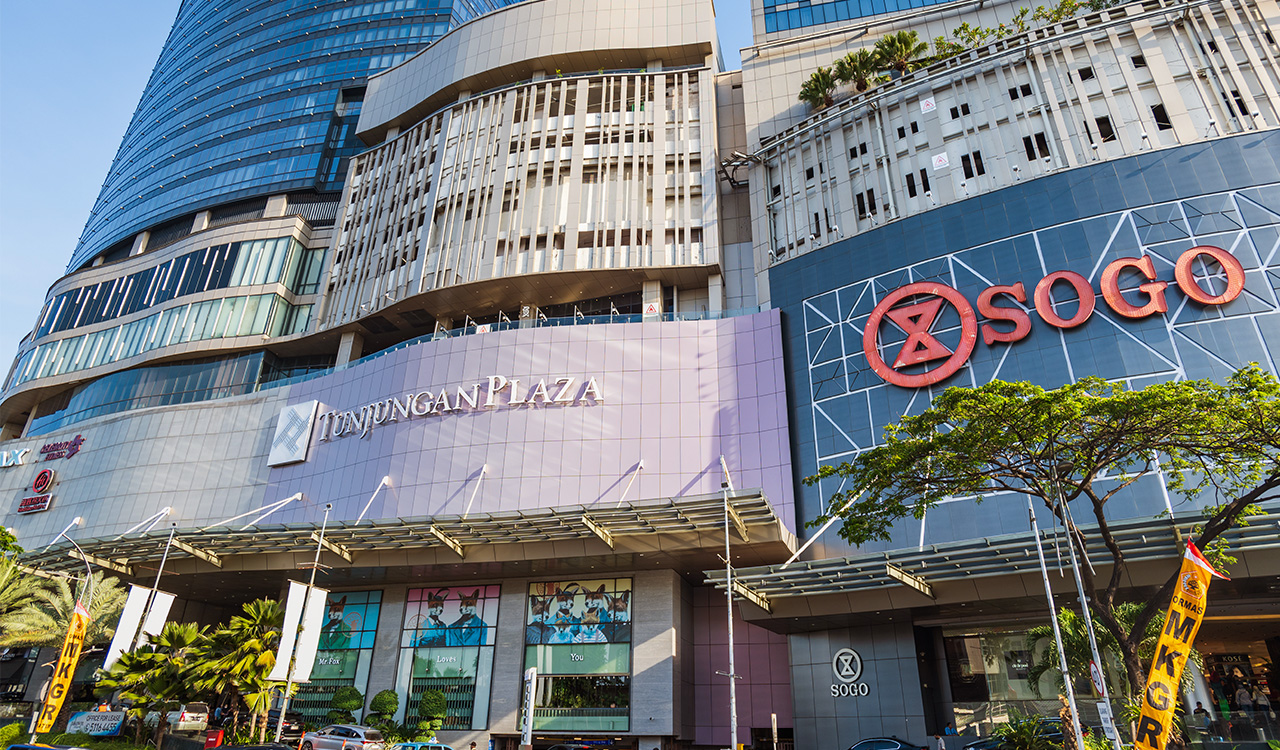We’re in Indonesia, East Java to be exact. Tunjungan Plaza rises high, glittering over the center of Surabaya. With nearly 150,000 square meters of leasable space and some 600 fashion and lifestyle brands, it’s Indonesia’s second-largest shopping center in Indonesia’s second-largest city (population three million).
Tunjunung Plaza sits among a cluster of older, and often shabbier, art deco hotels and high street shops that are preserved as historic sites commemorating the 1945 Battle of Surabaya, a pivotal moment in Indonesia’s independence after World War II.
The proximity of aspirational global luxury and reminders of Indonesia’s efforts to free itself from foreign exploitation underscores the contrasts in the Indonesian retail market landscape and the challenges marketers will face in the coming years in this nation of 286 million. The past looms over the present making forward progress precarious.
The Indonesian government has ongoing efforts to force foreign brands to commit to investing in Indonesian businesses or set up local manufacturing plants in exchange for market access. The government is emboldened to pressure foreign brands to invest in local production and distribution because it believes Indonesia is a seller’s market.
Just like its deposits of nickel and coal and acres of palm oil plantations, Indonesia regards its tens of millions of young, brand-savvy consumers as a natural resource, and its post-colonial, nationalist sentiment makes the government wary of foreign exploitation.
Vibrant Mall Life
Physical retail in Indonesia has become largely experiential. Families stroll past Chanel and Kate Spade window displays at Tunjungan Plaza as much to find selfie-worthy backdrops as to actually shop. A mile due east at Grand City, another (albeit less glittery) Surabaya mall, is bursting with family-friendly distractions for the kids, including locomotive rides, numerous mosh pits heaped with Legos and toy trucks and a skating rink.
Convenience stores, both domestic chains such as Indomaret and regional giants like Japan’s FamilyMart, use large parts of their in-store footprints for seating and food preparation. Indonesian consumers often make their own food and drink from in-store purchases—heating up noodles or sandwiches and making coffee or tea. These public spaces attract young consumers, conbini purchases in hand, as they enjoy an affordable café culture.
The Convenience Economy
The two glittering malls contrast sharply with Surabaya’s vibrant street life bustling with hand-drawn noodle carts and warungs (simple sidewalk cafes built with tarp and plywood), and provide a study in contrasts in Indonesia’s retail markets.
“The thing about Indonesian retail is that everything is convenient,” observes Arya Arland, an analyst with Indonesia brand and communications consultancy Flourish. “There’s always a guy coming past your house with snacks or fresh vegetables, and practically everything else is available through apps.” Grab and GoTo QR codes for delivery hang outside every warung, and ride-hailing app-based motor scooter taxis zip in between cars on traffic-clogged streets to get to work on time.
Convenience, and the need to meet poor consumers at their price points, have been driving an FMCG packaging revolution for decades. Snacks, powdered drinks, cosmetics and cleaning products are primarily sold in single-serve, single-use sachets. This has been particularly profitable for multinational brands such as Unilever (although a consumer backlash against foreign brands perceived to be supporting Israel in its war with Gaza has been biting into their market share).
These smaller packaging formats make roadside cart sales and app-based motor scooter grocery deliveries easier. FMCG makes up over 80 percent of Indonesian consumer spending, and sachets are sold in such great volumes that they are a substantial contributor to Indonesia’s plastic waste crisis.
As a result, Indonesian consumers of all income brackets are pretty sophisticated: brand-aware in the extreme, and have high expectations of their digital and physical sales channels. The hope for brand owners is that savvy Indonesian consumers will take their knowledge and affinity with them as they move up the disposable income ladder.
Indonesia Prosperity on Notice
Indonesia’s retail economy has had a reasonably smooth run over the last two years. Consumer spending in the third quarter this year grew to 256 trillion Rupiah ($15.8 billion), up 1.7 percent year-over-year, and consumer technology spend rose particularly high, 4.3 percent higher than third-quarter 2023 levels.
GDP growth has averaged a healthy five percent annually, although it has faltered lately, causing the central bank to cut interest rates to support the plans of recently inaugurated President Prabowo Subianto to increase economic growth to eight percent annually. Unlike much of the rich world, inflation has been low post-pandemic, and wage growth has been high thanks to an interventionist government Ministry of Manpower (which has recently put forward its plans to push up minimum wages by 6.5 percent in 2025, nearly twice their growth rates this year).
But there are concerns. Analysts estimate the gross merchandise value (GMV) of ecommerce sales in Indonesia will reach $62 billion this year—a healthy seven percent increase—but noticeably slower than 20 percent growth in 2023. Indonesia’s low inflation and high GDP growth have kept interest rates stable (which has also boosted consumer lending), but the interest rate differential in the U.S. and other high-inflation markets has also weakened the Rupiah, which in turn is nudging up the cost of imports. High levels of global geopolitical risk have also increased capital flight out of emerging markets, Indonesia included.
Shrinking Middle Class
The Indonesian government has ongoing efforts to force foreign brands to commit to investing in Indonesian businesses or set up local manufacturing plants in exchange for market access. The government is emboldened to pressure foreign brands to invest in local production and distribution because it believes Indonesia is a seller’s market.
Just like its deposits of nickel and coal and acres of palm oil plantations, Indonesia regards its tens of millions of young, brand-savvy consumers as a natural resource, and its post-colonial nationalist sentiment makes the government wary of foreign exploitation. It expects multinational corporations to pay handsomely for the right to access them—and, with the rich world aging and shrinking, government policymakers are betting that the collective value of Indonesia’s consumer classes is increasing.
However, there are signs this bet might not pay off. In August 2024, Statistics Indonesia published data that classified 48 million people as “middle class” (those who spend between roughly $200 and $1,000 per month). The 2019 census data placed Indonesia’s middle class at 57 million, 21 percent of the population as opposed to 17 percent today.
The reasons may have more to do with the reclassification of many people as ‘aspirational’ middle class, but it still points to less robust domestic consumption overall. Ironically, the Convenience Economy is powered by more people doing app-enabled gig work and increased reliance on digital tools and automation make things easier for many, but does not create as many stable full-time careers that build a middle class.
Embargoed
As we reported last year, efforts to block international social media from selling goods to Indonesian consumers through their platforms resulted in TikTok speedily acquiring a majority share in the leading domestic ecommerce giant Tokopedia for an estimated $840 million, and commitments to invest up to $1.5 billion in its digital retail channels and infrastructure.
While TikTok’s deep pockets may have preserved its Indonesian online retail business, it resulted in the absorption of what many regarded as the country’s most successful ecommerce champion, and as a result, narrowed the competitive playing field and limited consumer choice. This is arguably at odds with the government’s intended objectives of strengthening its domestic digital economy.
More recently, Indonesia has imposed restrictions on the sale of smartphones in the country, requiring vendors to sell models that are produced with at least 40 percent of its components sourced domestically. Most Asian vendors such as China’s Oppo and Xiaomi and Korea’s Samsung, have dutifully complied, and are reportedly increasing their Southeast Asian market presence as a result.
Android and Apple, however, have not ponied up. Apple did commit $100 million to local production facilities, but it was deemed insufficient by the government. Both Apple and Google have had their latest smartphone models banned for sale in Indonesia, and the Ministry of Industry has plans to double down on local content requirements soon, making the hurdle even higher if the American vendors want back in. This is likely to put a crimp in the growth of consumer tech sales.
Food Logistics: Retail Growth Barometer and Potential Hurdle
Other worrying signs about the Indonesian economy are a continued lack of transportation infrastructure and logistics services – particularly in the food service sector. Growing sales of fresh food, frozen meat and ready-to-eat meals, for instance, are straining the country’s cold storage infrastructure. Hasanuddin Yasni, Chairman of the Indonesia Cold Chain Association estimates the country has only three million tons of cold storage capacity, and fully half of this is concentrated in greater Jakarta and Surabaya. (By contrast, the U.S., with a population only 20 percent bigger, has more than 84 million tons of cold storage capacity.)
“Demand is so much greater than supply outside major cities, and the industry lacks the depth of technical expertise,” says Tejo Mulyono Executive Director at Indonesian cold chain logistics provider, PT Inter Mitra Transindo.
Mulyono notes that to plug demand holes, members have been building small portable refrigerated boxes that can be towed to food preparation centers or vegetable distribution markets. There has also been a concerted effort to build cold storage facilities using prefab parts and components imported from cost-effective producers (largely from China), and fleet management services for GPS-tracked refrigerated trucks are popping up nationwide.
These work-around solutions to Indonesia’s cold storage shortage reflect the essence of the Indonesian Convenience Economy: adaptation propelled into action. If this innovative spirit is applied to address Indonesia’s larger logistics challenges, retailers might be able to more efficiently reach consumers—whether ‘aspirational’ or actual middle class—outside of the country’s urban core.
Opening up new paths to rural and ex-urban consumers would be taking a leaf out of China’s domestic market growth playbook, and given the strong presence of Chinese retailers and brands in Indonesia, those lessons will be useful. This assumes that Indonesia’s exploitation-wary policymakers do not overplay their hand with insular requirements, which they appear dangerously close to doing.





